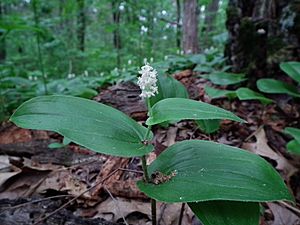Canadian may-lily facts for kids
Quick facts for kids Canadian may-lily |
|
|---|---|
 |
|
| Maianthemum canadense | |
| Scientific classification | |
| Synonyms | |
|
Canadian may-lily (also called Canada mayflower or wild lily-of-the-valley) is a small flowering plant that grows year after year. It is found in the understory (the plants growing beneath the main forest canopy) of forests. This plant is native to Canada and the northeastern United States. You can find it from Yukon and British Columbia in the west, all the way east to Newfoundland and St. Pierre and Miquelon. It grows in both coniferous (evergreen) and deciduous (leaf-shedding) forests.
This plant usually appears in two ways. Sometimes, it's just a single leaf growing from the ground, without any flowers or fruits. Other times, it's a stem with 2-3 leaves that produces flowers and later, fruits. When it flowers, it has clusters of 12 to 25 white, star-shaped flowers that stand above the leaves.
Contents
About the Plant
These plants typically grow to be about 10 to 25 centimeters (4 to 10 inches) tall. They grow from underground stems called rhizomes, which spread out and have roots only at their joints. Some plants might have only one leaf and no flowers or fruits (these are called sterile plants). Plants that do flower usually have 2 or 3 leaves.
Leaves
The leaves are usually 4.5 to 9 cm (1.8 to 3.5 inches) long and 3 to 5.5 cm (1.2 to 2.2 inches) wide. They have a pointed tip. The lowest leaves are often shaped like an egg, with two rounded parts at the bottom. The leaves higher up on the stem are usually heart-shaped and sit on a short stalk, about 1 to 7 mm long.
Flower Clusters
The plant produces clusters of 12 to 25 white, star-shaped flowers. These flowers are arranged in a special type of cluster called a raceme. This means the flowers grow along a central stem, with 1 to 3 (usually 2) flowers at each point. The flowers at the bottom of the cluster open first. Each flower has a thin stalk, called a pedicel, which is about 3 to 7 mm long.
Flowers and Fruits
The flowers bloom from spring to mid-summer. They have four noticeable white parts, called tepals, which are about 1.5 to 2 mm long. After the flowers, the plant produces a small, round berry. Each berry contains 1 or 2 round seeds. The berries are about 4 to 6 mm across. They start out mottled red (with spots of different colors) in early summer and turn a deep red by mid-summer.
New seeds are not made very often. Most of these plants in one area are actually clones of each other. This means they spread by their shallow, white rhizomes (underground stems) rather than by seeds.
Where It Grows
You can find the Canadian may-lily in Canada, from southeastern Yukon and the southern Northwest Territories, east through British Columbia, and all the way to Newfoundland and Labrador, including St. Pierre and Miquelon. In the United States, it grows in the northern states, from the Dakotas eastward. It also extends south along the Appalachian Mountains. You might even find some scattered groups in Colorado, Wyoming, Nebraska, and Kansas.
Home and Environment
This plant mainly lives in the boreal forest understory. It also grows in lower areas of the Rocky Mountains, up to 1800 meters (about 5,900 feet) high. It prefers moist woods but can also be found in sandy pine forests in the northern regions. It can even survive in open clearings where trees have been removed.
Similar Plants
Most plants in the Maianthemum family have flower parts in groups of three. However, the Canadian may-lily (M. canadense) is special because its flowers have four tepals and four stamens. This is similar to its close relatives, Maianthemum bifolium and Maianthemum dilatatum.
The areas where these similar species grow do not overlap. Maianthemum bifolium is found in temperate Eurasia (Europe and Asia). Maianthemum dilatatum mostly grows along the coast from Alaska south to northwestern California, and also from Mongolia to Japan.
Another small plant, Maianthemum trifolium, has a similar distribution to M. canadense. But its flower parts are in groups of three, and its leaf bases are narrow, not heart-shaped. Also, M. trifolium prefers wet places like bogs.
Varieties
Currently, scientists do not officially recognize different types (subspecies) of the Canadian may-lily. However, in the western part of its range, some plants with hairs and consistently larger leaves have been called var. interius.
Gallery
Images for kids
See also
 In Spanish: Maianthemum canadense para niños
In Spanish: Maianthemum canadense para niños







